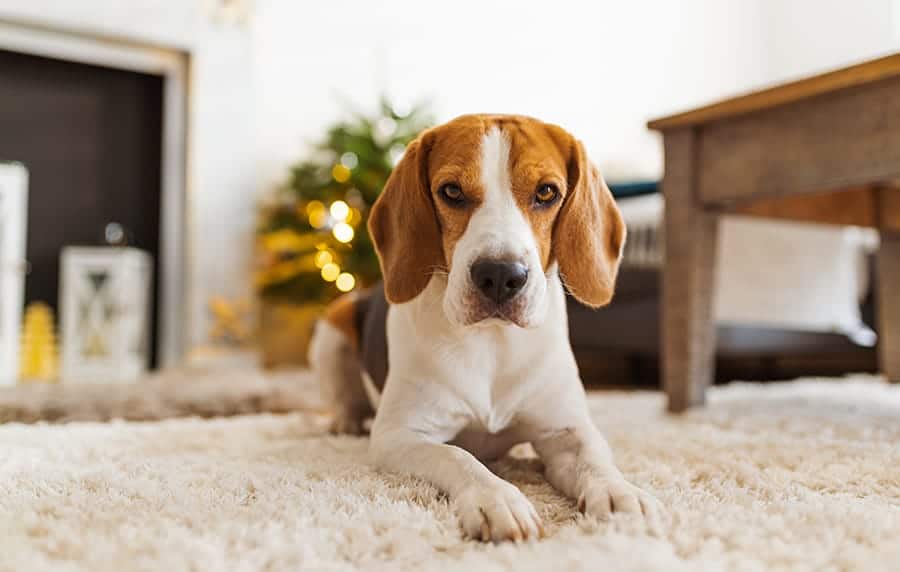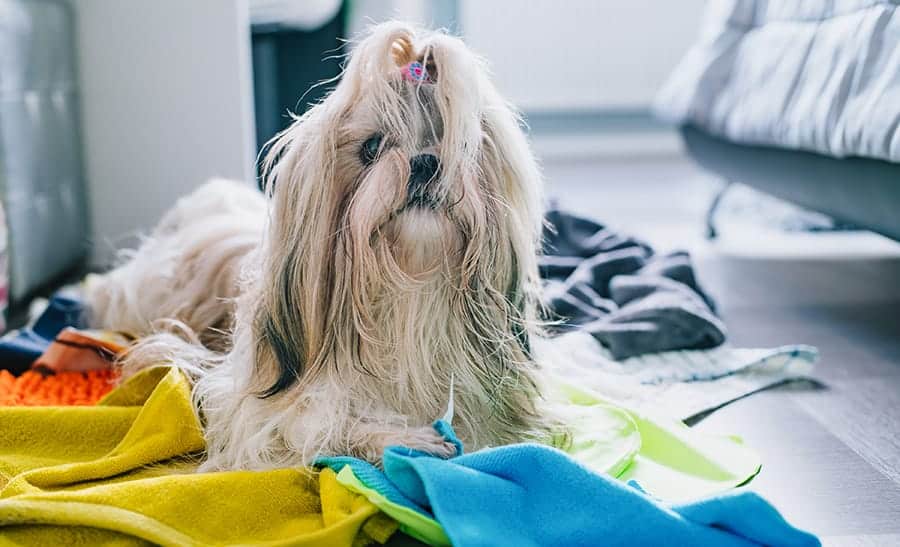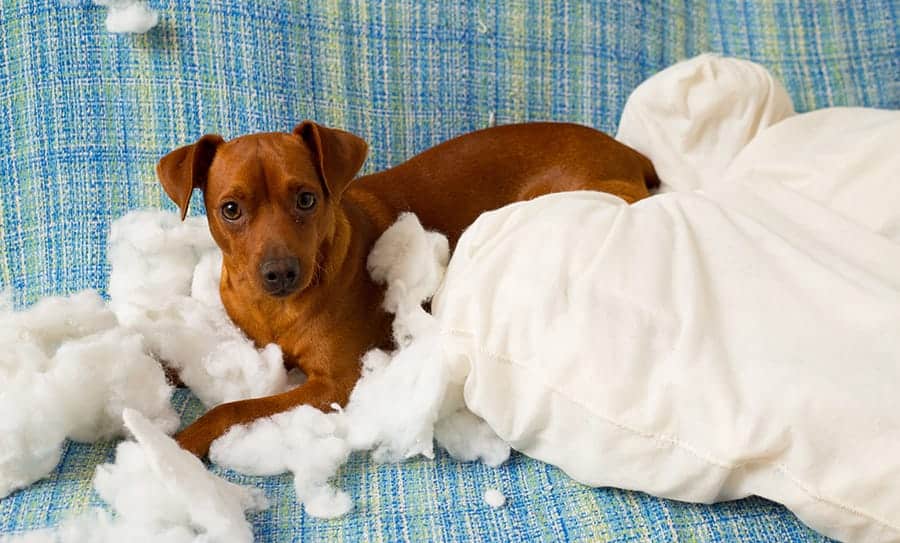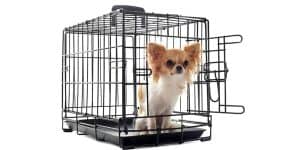How to Puppy Proof Your House – 10 Simple Steps!
Published: Last updated: by Jessi Larson Affiliate Disclosure: We hope you love the products we've recommended! As an Amazon Associate we earn a small share from qualifying purchases.Congratulations on your new dog! As a new pet parent, you’re likely wondering how to puppy-proof your house. That’s a great question, and we’ll show you how in 10 easy steps.

Dog-proofing your home can seem daunting. After all, the process is intended to ensure the safety of both your new pup and your home. No pressure, right?
While dog-proofing your house isn’t the most fun thing to do in the world, it can be a whole lot easier if you follow these 10 simple steps.
Our story
We welcomed Toby into our home in 2013. He was a 12-week-old Labrador Retriever with a sweet face and droopy, soulful eyes that melted your heart.
Like all puppies, Toby had lots of energy and was constantly curious. He loved to explore and wanted to bite or lick everything he saw.
The extra challenge for us, however, was that Toby got really big really quickly. By big, I mean huge. He essentially had the size and strength of a full-grown dog while still being a clumsy, hyper, determined puppy.
Puppy-proofing the house felt like a nonstop endeavor. Especially since we couldn’t corral him off in a smaller space since he’d just knock down the barriers.
He chewed on table legs, destroyed dog beds, and found every stray cord we missed. When he wasn’t damaging property, he tried to eat food out of the garbage can and nibbled on the plants.
It was exhausting.
Today, Toby is a mellow 110-lb gentle giant, so it’s strange to think just how destructive he could be in the beginning.
Looking back, however, there are many things we could have done better. These 10 steps will save you lots of time and energy, protect your property, and, most importantly, keep your dog safe.
How to Puppy Proof Your House: 10 Easy Steps
1. Pick up the floor and keep it clean
First things first: When you get a puppy, you’ll have to remember to pick up items on the floor and always keep it clean.
Inevitably, puppies seem to find the one object you left out. Never let your guard down! (I had not one but two phone chargers chewed up because I spaced out just for a moment.)
Also, you may think you’ve gotten everything, but to really check, lie down on the floor and look around. It sounds silly, but you’ll see things from your dog’s vantage point and find items you would have totally missed.
2. Gate off restricted areas
Dog gates are huge when you’re still in the puppy phase. They let you corral your dog to a certain part of the home that you know is safe and secure.
This also means you don’t have to puppy-proof every single space in your house, which would be a huge endeavor!
Nowadays, there are lots of different gate options with different sizes and styles, so you can find one that perfectly fits your space.
This portable gate is a good option:
Or you can get an indoor pen and put it in the middle of the room to keep your dog contained.
3. Secure the trash
As you puppy-proof, don’t forget the trash can! Many dogs just love digging into the garbage and finding any morsel of food they can.
Certain breeds are extra big chow hounds. For example, if you have a Beagle, Labrador Retriever, Golden Retriever, Rottweiler, or Pug, you should definitely watch the waste bin!
This isn’t an exhaustive list, though. And it all depends on your dog’s personality.
From our experience, pup parents have three options:
1. Put the trash completely out of reach
You can secure the trash can in an enclosed space like a pantry with a door or underneath the sink if your home layout allows.
2. Get a trash can that’s much taller than your dog
For smaller dogs, you could get a garbage can that towers over them. This means they have no chance of reaching the top, but be careful for the canines who like to tip things over.
3. Buy a dog-proof garbage can
Options 1 and 2 weren’t a possibility for us when we got Toby, and he loved to sneak into the garbage and gobble up everything in sight.
We were stumped – until we found a dog-proof garbage can.
When I found this on Amazon, it was like the heavens shined down on us. I was so tired of having to chase Toby out of the trash and constantly keep an eye on it.
This is the model that we got and have been using for years:
It lets you lock the lid so a dog can’t get inside. And let me tell you, it works!
To this day, Toby tries to get inside the bin but is blocked by the lock. We hear thumps when he’s trying to break in, but he’s never successful.

4. Watch out for cords
Another canine conundrum when it comes to how to puppy-proof your house is cords.
Dogs love to nibble on any kind of cord they can see. Appliance cords. Phone and computer charger cords. You name it.
Not only is this inconvenient for you, it can be downright dangerous for dogs.
Even though I knew I should put my chargers away, I would often forget when my phone or computer was about to die and quickly plugged them back in. Sure enough, I’d leave the chargers there, and Toby would swoop in for the chew.
5. Check for poisonous plants
If you have plants or flowers in your home, always check to see if they’re poisonous to pups.
If they are, we highly recommend you get rid of them completely. Or at least put them in an impossibly high place.
If they aren’t, it’s still a good idea to put them away if your dog is likely to knock them over or try to eat them.
Every now and then, we still catch Toby eating dirt from our potted plant. (He’s a weird one, I tell you!)
6. Put away hazardous materials
When you look into how to puppy-proof your house, I can’t stress enough how important it is to put away any hazardous materials and ensure there’s no way for your dog to reach them.
This includes medicine, cleaning supplies, yard sprays, vehicle chemicals, and insect and rodent repellents.
Just this week, one of our readers shared how her previous dog passed after getting into rat poison in their garage. As you can imagine, she was absolutely devastated.
Always keep an eye out for anything that’s potentially poisonous to your pup.

7. Keep the lid down
Dogs love to drink out of the toilet. I’m not sure I’ll ever understand why.
Researchers say it’s because the water in the toilet is fresher and cooler than what’s in their dish.
That makes sense, but unfortunately, the toilet is full of lots of germs that aren’t good for your dog.
After you use the loo, don’t forget to close the lid behind you.
8. Always close windows and doors
We’ve been focused on all the hazards inside the home, but there are many more outside.
You don’t want your dog to escape without you knowing! That’s why it’s important to always keep the doors and windows closed and secured.
9. Put the nice stuff away for a while
Let’s face it, dogs are destructive. As puppies, they like to run around, eat lots of things that aren’t food and go to the bathroom in places they shouldn’t.
Is it all worth it? 100 percent.
But to save your sanity – and your home – it might be a good idea to put the nice stuff away for a while. Just until you can completely trust your pooch.
10. Create a safe space
When your dog is at the stage where you can’t quite trust them alone in a room, it’s always a good idea to create a safe space that you know they can’t and won’t destroy.
For example, that could be a cordoned-off area free of any objects. Or a kennel they consider their trusted space. Or a dog pen that completely contains them.
Having an area like this will help keep them safe and give you a break mentally and physically.

Other Helpful Tips
As you look into how to puppy-proof your house, there are other things you can do to ensure your dog doesn’t destroy your home.
1. Make sure they get enough physical and mental stimulation
If your dog is bored and restless, they’re more prone to destructive behavior. You can wear out your pup with regular walks, games of fetch, trips to the dog park, or any activities that get them moving.
Mental stimulation is also important. If you’re looking for ideas, check out these six genius games for canine companions.
2. Understand your dog’s breed and personality
When you question how to puppy-proof your house, an important consideration is your dog’s breed (if you know it) and temperament.
Understanding who they are and how they behave will help you know where to focus your energy.
3. Get everyone involved
Dog-proofing a home doesn’t work if the entire household isn’t involved. It just takes one person to act negligently, and all bets are off.
As a rule of thumb, make sure everyone is on the same page and committed to puppy-proofing the home you all inhabit.
Bonus video
If you’re more of a visual person, take a look at this video from AKC on the topic of how to puppy-proof your house. It has lots of great advice and real-life examples.
Conclusion: How to Puppy Proof Your House
These tips on how to puppy-proof your house will go a long way to keep your dog healthy and happy and your house protected.
Just because your house is dog-proofed, however, that doesn’t mean you can take your eyes off your pooch. When they’re under one year old, it’s important to watch them vigilantly at all times.
As your dog gets older, you’ll find you can relax and start to ease these restrictions, slowly but surely!






 Getting a New Dog?
Getting a New Dog?
1 Comment
How do I get her to stop using the bathroom in the house and when should I feed her and give water